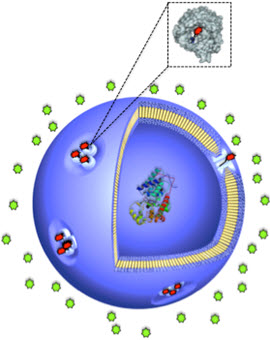

Nanocompartment with closed protein gates (red).
University of Basel
Tiny nanovesicles can protect active agents until they arrive in specific environments, such as at the target site in the body. In order to trigger a chemical reaction and release the contents at that location, the outer casing of the synthetically produced vesicles must become permeable at the correct point in time.
Working under Prof. Cornelia Palivan, researchers from the Swiss Nanoscience Institute have now developed a membrane gate that opens on demand. This means that the enzymes inside a nanocapsule become active under exactly the right conditions and act on the diseased tissue directly.
Reacting to changes in pH
The gate is made up of the chemically modified membrane protein OmpF, which responds to certain pH values. At neutral pH in the human body, the membrane is impermeable – but if it encounters a region with acidic pH, the protein gate opens and substances from the surrounding area can enter the nanocapsule.
In the resulting enzymatic reaction, the capsule’s contents act on the incoming substrate and the product of this reaction is released. This method could be applied, for example, to inflamed or cancerous tissue, which often exhibits a slightly acidic pH value.
Until now, permeability in nanovesicles has been achieved using natural proteins that operate as pores in the protective membrane, allowing both the substrate to enter and the product of the enzymatic reaction to escape.
However, fields such as medicine or controlled catalysis call for more precise distribution in order to achieve the greatest possible efficiency of the active agent. In collaboration with Prof. Wolfgang Meier’s team, the chemists working under Prof. Palivan were able for the first time to integrate a modified membrane protein into an artificially produced nanocapsule, which opened only if it encountered corresponding pH values.
The experiments performed at the university are part of the National Center of Competence in Research Molecular Systems Engineering (NCCR MSE), and the Swiss Nanoscience Institute (SNI).
Originalbeitrag
T. Einfalt, R. Goers, I.A. Dinu, A. Najer, M. Spulber, O. Onaca-Fischer, C. G. Palivan
Stimuli-triggered activity of nanoreactors by biomimetic engineering polymer membranes
Nano Letters ¦ doi: 10.1021/acs.nanolett.5b03386
Further information
Tomaz Einfalt, University of Basel, Department of Chemistry, Swiss Nanoscience Institute, tel. +41 61 26 7 38 37 email: tomaz.einfalt@unibas.ch
https://www.unibas.ch/en/News-Events/News/Uni-Research/Steuerbare-Proteinschleus…














